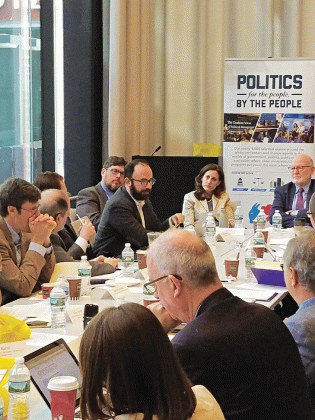
Mary Chiappetta / LSU Manship School News Service
By now you’ve probably all heard the popular buzzwords “fake news,” but would you recognize fake news if you saw it?
Eighty percent of Americans in a nationally representative sample express confidence in their ability to recognize fake news, according to recent research from the Public Policy Research Lab at LSU’s Manship School of Mass Communication. Yet many remain vulnerable.
Willingness to believe fake news reports may be rooted in a variety of factors, such as our increasingly polarized political climate, according to experts at a conference hosted Thursday by the Manship School’s Reilly Center for Media & Public Affairs and George Washington University.
Social media platforms like Facebook have opened political debate more broadly to the public, but this comes at the cost of every issue’s infusion with partisan red/blue rhetoric, according to Lara Brown, director of George Washington’s Graduate School of Political Management. This raises the stakes and makes people more likely to believe information that confirms their own preferences.
“When the stakes are high, people decide to put outcome over principle,” said Jack Hamilton, LSU professor of journalism and conference organizer.
Differences between traditional media and internet platforms also make an environment ripe for the spread of fake news.
For many years, newspapers and television news shows acted as gatekeepers to verify information and keep discourse civil. “The media were creating a common space,” said Tom Rosenstiel, director of the American Press Institute.
But social media platforms rely on user data to define people by what separates them. This produces conversations in which “people are either hysterical, or euphoric,” Rosenstiel said, adding that sometimes people’s comments on posts on social media do not match up with the opinions they report when not on social media.
The heated presidential campaign in 2016 saw its share of fake news stories. In the fall, millions shared a sensational story on a website called Christian Times Newspaper echoing then-candidate Donald Trump’s concern that the election would be rigged. Thousands of fake ballots, the story claimed, were found in a warehouse in Ohio, waiting to dilute the results and aid the Democratic nominee, Hillary Clinton.
The catch? The story was entirely fabricated and circulated by a young college graduate hard-up for cash. That and other fake stories brought him $22,000 in ad revenue and demonstrated the incredible power of fake news to shape the public narrative.
The conference also identified the role of growing public distrust in institutions, including the media, in the spread of fake news.
Jay Cost, contributing editor for the Weekly Standard, noted that consolidation of news outlets in Washington and New York may contribute to public association of the media with detached, elite institutions. The media also frequently cites expert sources instead of regular citizens, possibly making people feel left out, Brown said.
This has provided an opening for figures like President Trump, whose informal method of speaking suggests authenticity, said Michael Cornfield, a George Washington University professor.
Declines in local news also might help fake news spread because national news and politics increasingly dominate the agenda, making it difficult to see any story outside of a partisan frame, Brown said.
Fake news sources also find it easier to mimic local news outlets than well-known national ones, said Ryan Thornburg, the director of a news lab at the University of North Carolina. Most people recognize sites like ABC. But, he said, when less familiar sites resembling local outlets confirm people’s biases, they might slip under the radar.
The experts suggested that instead of helping individuals develop skills to identify what is “fake,” it might be better to think about the problem in terms of what people care about and have the power to fix.
This focus on what the public can do rather than what it cannot makes the conversation more engaging and might help society become more immune to fake news.
